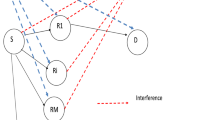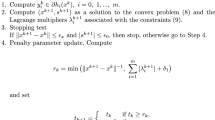Abstract
In this paper, we devote to maximize the secrecy energy efficiency (SEE) for a cloud radio access network where exists an eavesdropper wiretapping information from remote radio head. We first establish the system model and then formulate the power optimization problem to maximize the SEE of the system subject to the fronthaul capacity and transmit power constraints. To address this nonconvex problem, we first convert the fractional objective function into a subtractive form and two algorithms are then proposed to solve it. Simulation results indicate that the proposed the iterative optimization algorithms can obtain higher SEE and present the merit of AN in enhancing the system performance when compared with conventional methods.















Similar content being viewed by others
References
Wang, Y., Hua, M., Liu, Z., Zhang, D., Dai, H., & Hu, Y. (2019). Joint scheduling and trajectory design for UAV-aided wireless power transfer system. In V. C. M. Leung, H. Zhang, X. Hu, Q. Liu, & Z. Liu (Eds.), 5G for future wireless networks (pp. 3–17). Cham: Springer International Publishing.
Dai, H., Huang, Y., Xu, Y., Li, C., Wang, B., & Yang, L. (2019). Energy-efficient resource allocation for energy harvesting-based device-to-device communication. IEEE Transactions on Vehicular Technology, 68(1), 509–524.
Ji, B., Xing, B., Song, K., Li, C., Wen, H., & Yang, L. (2019). The efficient BackFi transmission design in ambient backscatter communication systems for IoT. IEEE Access, 7, 31397–31408.
Hao, W., Chu, Z., Zhou, F., Yang, S., Sun, G., & Wong, K. (2019). Green communication for NOMA-based CRAN. IEEE Internet of Things Journal, 6(1), 666–678.
Wu, D., Wang, J., Hu, R. Q., Cai, Y., & Zhou, L. (2014). Energy-efficient resource sharing for mobile device-to-device multimedia communications. IEEE Transactions on Vehicular Technology, 63(5), 2093–2103.
Zuo, J., Zhang, J., Yuen, C., Jiang, W., & Luo, W. (2016). Energy efficient user association for cloud radio access networks. IEEE Access, 4, 2429–2438.
Peng, M., Li, Y., Jiang, J., Li, J., & Wang, C. (2014). Heterogeneous cloud radio access networks: A new perspective for enhancing spectral and energy efficiencies. IEEE Wireless Communications, 21(6), 126–135.
Dai, H., Huang, Y., Li, C., Li, S., & Yang, L. (2017). Energy-efficient resource allocation for device-to-device communication with WPT. IET Communications, 11(3), 326–334.
Peng, M., Wang, Y., Dang, T., & Yan, Z. (2017). Cost-efficient resource allocation in cloud radio access networks with heterogeneous fronthaul expenditures. IEEE Transactions on Wireless Communications, 16(7), 4626–4638.
Chih-Lin, I., Huang, J., Duan, R., Cui, C., Jiang, J., & Li, L. (2014). Recent progress on C-RAN centralization and cloudification. IEEE Access, 2, 1030–1039.
Zhao, R., Tan, X., Chen, D., He, Y., & Ding, Z. (2018). Secrecy performance of untrusted relay systems with a full-duplex jamming destination. IEEE Transactions on Vehicular Technology, 67(12), 11511–11524.
Zou, Y., & Wang, G. (2016). Intercept behavior analysis of industrial wireless sensor networks in the presence of eavesdropping attack. IEEE Transactions on Industrial Informatics, 12(2), 780–787.
Li, Q., Hong, M., Wai, H., Liu, Y., Ma, W., & Luo, Z. (2013). Transmit solutions for MIMO wiretap channels using alternating optimization. IEEE Journal on Selected Areas in Communications, 31(9), 1714–1727.
Chu, S. (2019). Secrecy analysis of modify-and-forward relaying with relay selection. IEEE Transactions on Vehicular Technology, 68(2), 1796–1809.
Zhao, N., Yu, F. R., Li, M., & Leung, V. C. M. (2016). Secure transmission in interference alignment (IA)-based networks with artificial noise. In 2016 IEEE 83rd Vehicular Technology Conference (VTC Spring) (pp. 1–5).
Zheng, L., Sang, L., Liu, J., Lu, B., & Dong, Z. (2018). Maximising the degrees of freedom of the physical-layer secured relay networks with artificial jamming. IET Communications, 12(6), 665–671.
Qiang, Y., Lu, G., Liu, B., & Li, Y. (2017). Optimal energy harvesting-aided spectrum sensing sensors scheduling in cognitive radio networks. In 2017 9th International Conference on Wireless Communications and Signal Processing (WCSP) (pp. 1–5).
Hu, D., He, L., & Wang, X. (2011). An efficient pilot design method for OFDM-based cognitive radio systems. IEEE Transactions on Wireless Communications, 10(4), 1252–1259.
Cepheli, Ö., & Kurt, G. K. (2013). Analysis on the effects of artificial noise on physical layer security. In 2013 21st Signal Processing and Communications Applications Conference (SIU) (pp. 1–4).
Liao, W., Chang, T., Ma, W., & Chi, C. (2011). QoS-based transmit beamforming in the presence of eavesdroppers: An optimized artificial-noise-aided approach. IEEE Transactions on Signal Processing, 59(3), 1202–1216.
Park, S., Simeone, O., & Shamai, S. (2017). Fronthaul quantization as artificial noise for enhanced secret communication in C-RAN. In 2017 IEEE 18th International Workshop on Signal Processing Advances in Wireless Communications (SPAWC) (pp. 1–5).
Zhao, N., Yu, F. R., Li, M., Yan, Q., & Leung, V. C. M. (2016). Physical layer security issues in interference-alignment-based wireless networks. IEEE Communications Magazine, 54(8), 162–168.
Zhao, N., Cao, Y., Yu, F. R., Chen, Y., Jin, M., & Leung, V. C. M. (2018). Artificial noise assisted secure interference networks with wireless power transfer. IEEE Transactions on Vehicular Technology, 67(2), 1087–1098.
Cheng, F., Gui, G., Zhao, N., Chen, Y., Tang, J., & Sari, H. (2019). UAV-relaying-assisted secure transmission with caching. IEEE Transactions on Communications, 67(5), 3140–3153.
Wang, Y., Zhou, M., Tian, Z., & Tan, W. (2018). Beamforming and artificial noise design for energy efficient cloud RAN with CSI uncertainty. In 2018 IEEE Global Communications Conference (GLOBECOM) (pp. 1–6).
Li, C., Zhang, S., Liu, P., Sun, F., Cioffi, J. M., & Yang, L. (2016). Overhearing protocol design exploiting intercell interference in cooperative green networks. IEEE Transactions on Vehicular Technology, 65(1), 441–446.
Zappone, A., & Jorswieck, E. (2015). Energy efficiency in wireless networks via fractional programming theory. Foundations and Trends in Communications and Information Theory, 11, 185–396.
Lin, Y., Wang, G., Meng, C., Heng, W., & Chen, X. (2018). Secrecy energy efficiency optimization in AN-aided MISO system with energy harvesting. In 2018 IEEE International Conference on Communications (ICC) (pp. 1–6).
Wang, G., Meng, C., Heng, W., & Chen, X. (2018). Secrecy energy efficiency optimization in AN-aided distributed antenna systems with energy harvesting. IEEE Access, 6, 32830–32838.
Acknowledgements
This work was supported by National Natural Science Foundation of China under Grants 61901241, 61671144, 61801170, 61801257, Shandong Provincial Natural Science Foundation, China under Grant ZR2017BF028, Henan Province Science and Technology Research Project under Grant 182102110401, Open Fund of Acoustic Science and Technology Laboratory under Grant SSKF2018003, Platform for Innovation and Entrepreneurship Training Program of Qingdao University.
Author information
Authors and Affiliations
Corresponding author
Additional information
Publisher's Note
Springer Nature remains neutral with regard to jurisdictional claims in published maps and institutional affiliations.
Rights and permissions
About this article
Cite this article
Meng, L., Wang, Q., Ji, Z. et al. Resource allocation on secrecy energy efficiency for C-RAN with artificial noise. Wireless Netw 26, 639–650 (2020). https://doi.org/10.1007/s11276-019-02160-x
Published:
Issue Date:
DOI: https://doi.org/10.1007/s11276-019-02160-x




